Witness nature’s grand performance through the lens of time-lapse photography, where dramatic seasonal transitions unfold in stunning detail. Position your camera at a fixed vantage point overlooking a diverse landscape – ideally combining water bodies, deciduous trees, and open meadows for maximum seasonal impact. Scout locations during golden hour, when shifting shadows reveal the subtle textures and patterns that will become dramatic transformations in your final sequence. Set your intervalometer to capture images every 24-48 hours throughout the season, ensuring consistent lighting conditions by shooting at the same time each day. Mount your camera in a weatherproof housing, secured against wind and elements, with a clear view of the horizon and minimal human interference. Choose distinctive natural markers – a lone maple tree, a rocky outcrop, or a winding stream – to anchor your composition and highlight nature’s changing palette across weeks and months.
Best Locations for Seasonal Time-Lapse Photography in Ontario
Iconic Viewpoints in Frontenac
As you explore Ontario’s wild spaces, Frontenac Provincial Park offers several prime locations for capturing the dramatic seasonal transitions. The Mink Lake Lookout, accessible via a moderate 2.5km hike, provides a sweeping panorama of the surrounding wilderness, making it perfect for documenting the changing colors of maple and oak forests below.
Crane’s Roost, perched atop one of the park’s highest points, offers unobstructed views of three connecting lakes and is particularly stunning during sunrise. Pro tip: arrive 30 minutes before dawn to set up your equipment and catch the first light painting the landscape.
The Cedar Lake Loop boardwalk presents unique opportunities to capture wetland transformations throughout the seasons. Here, you can document everything from spring water lilies to winter ice formations, all framed by towering white pines.
For those seeking less-traveled spots, the Buck Lake Lookout offers equally impressive vistas without the crowds. This hidden gem is especially magical during fall colors and provides clear sight lines for tracking storm systems moving across the park.
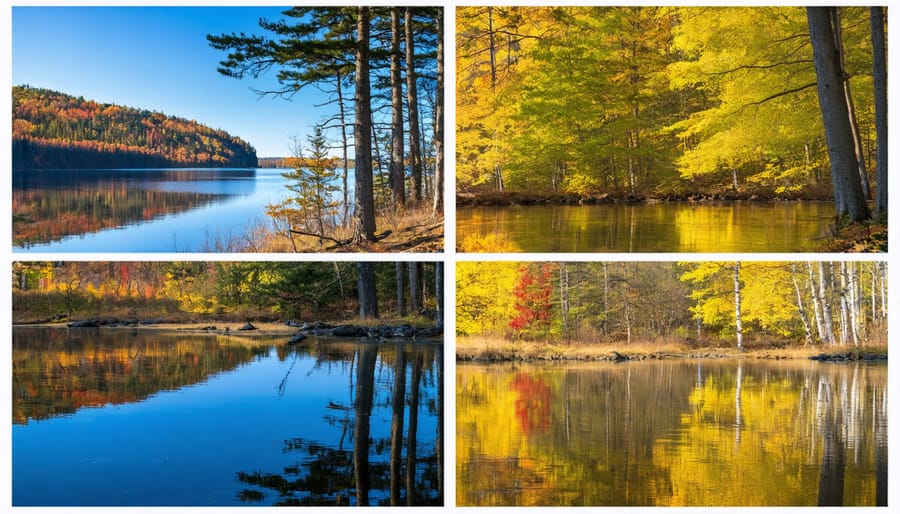
Hidden Gems in Surrounding Parks
While popular parks like Algonquin draw crowds for seasonal photography, some of Ontario’s best time-lapse opportunities lie in its lesser-known corners. Take Silent Lake Provincial Park, where secluded granite outcrops offer uninterrupted views of color-changing maples without the usual photographer traffic. The park’s remote location means minimal light pollution, perfect for capturing star trails against autumn skies.
For those seeking hidden viewpoints in Ontario Parks, Frontenac Provincial Park’s abandoned mica mines provide unique vantage points for documenting seasonal transitions. The weathered rock faces create natural frames for your time-lapse sequences, while the surrounding wetlands showcase dramatic transformations from summer lotus blooms to winter ice formations.
Don’t overlook Bon Echo’s lesser-visited western trails, where ancient white pines stand sentinel over secluded bays. These spots offer remarkable opportunities to capture ice formation and spring thaw sequences, especially along the park’s quiet northern shore. Pack a lightweight tripod as some of these locations require short hikes.
Charleston Lake Provincial Park harbors several hidden coves perfect for long-term camera setups. The park’s diverse ecosystem transitions dramatically through the seasons, from spring trilliums carpeting the forest floor to winter’s crystalline formations along the shoreline. Pro tip: scout these locations during shoulder seasons when fewer visitors are around, and always mark your GPS coordinates for consistent shot placement across multiple visits.
Remember to practice Leave No Trace principles while setting up your equipment, and consider using camera covers during inclement weather to protect your gear while capturing these hidden treasures.
Essential Time-Lapse Equipment for the Trail
Weather-Proof Setup Tips
Protecting your camera gear during a long-term time-lapse project is crucial, especially in Ontario’s diverse weather conditions. Start with a sturdy, weatherproof camera housing – I learned this lesson the hard way after losing equipment to an unexpected summer storm! Look for housings rated IPX6 or higher for the best protection against rain and snow.
A reliable power solution is essential. Consider using a solar-powered battery system to keep your camera running continuously. Pro tip: position the solar panel facing south at a 45-degree angle for optimal charging in our latitude.
Don’t forget about lens protection. A quality UV filter is your first defense against moisture and debris, while a deep lens hood helps prevent water droplets from settling on the glass. I always add silica gel packets inside the housing to combat condensation – they’re an affordable lifesaver during humid summer mornings.
Cable management is often overlooked but critical. Use waterproof connectors and route all cables downward to prevent water from running into your setup. Create a “drip loop” by letting cables hang below the connection points before going up into the housing.
For extra protection during severe weather, consider adding a small awning above your setup. A simple piece of clear acrylic works wonders without interfering with your shot.
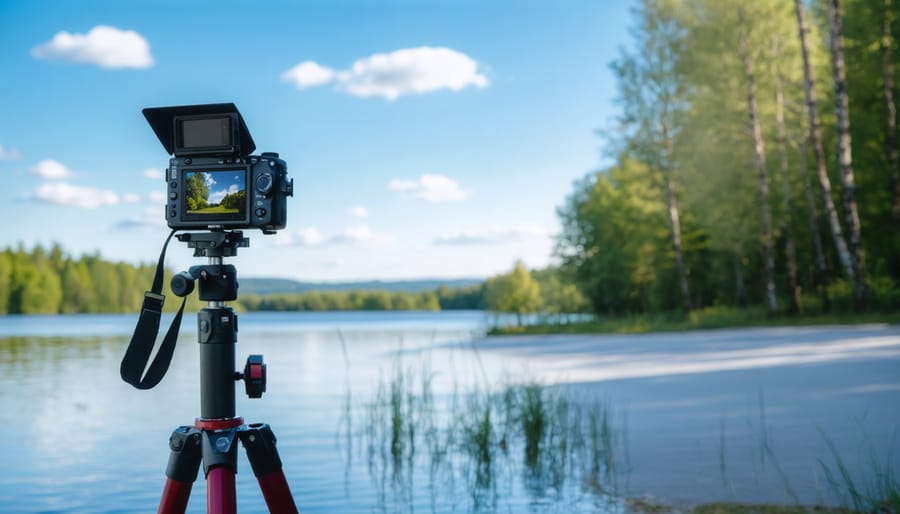
Power Solutions for Extended Shoots
When shooting time-lapses over extended periods, reliable power solutions are essential for capturing those magical seasonal transitions. For remote locations in Ontario’s parks, I recommend bringing at least two high-capacity external battery packs rated at 20,000mAh or higher. These can keep your camera running for several days, especially when paired with a solar charging setup.
Speaking from experience, I’ve found that combining a 100W portable solar panel with a power station offers the most reliable solution for multi-week shoots. Set up your panel facing south, and consider using an adjustable mount to maximize sun exposure throughout the day. During fall and winter months, when daylight is limited, having a backup gas-powered generator can be a lifesaver, though remember to check park regulations first.
For camera power management, consider using a dummy battery connected to your power station. This setup eliminates the need to swap batteries and reduces the risk of camera movement. I also recommend using low-power intervalometers and weatherproof power connection boxes to protect your setup from Ontario’s unpredictable weather.
Pro tip: Calculate your power needs before heading out by testing your camera’s power consumption rate at home. Add 30% extra capacity to account for cold weather, which can significantly impact battery performance.
Timing Your Seasonal Shots
Peak Color Windows
To capture Ontario’s most dramatic seasonal transitions, timing is everything. The most spectacular peak seasonal changes typically occur during specific windows throughout the year, with fall offering the most dramatic displays.
For autumn colors, mid-September to mid-October is your prime window, with the northernmost parks showing color first. Algonquin Park usually reaches peak color during the last week of September, while more southern locations like Frontenac Provincial Park peak in mid-October. Pro tip: check local fall color reports online for real-time updates.
Spring transitions are best captured from late March through April, when winter’s white blanket gives way to emerging greenery. The “mud season” might not sound glamorous, but it offers incredible opportunities to capture nature’s awakening.
Summer to fall transitions begin subtly in August, with individual maple leaves starting to turn. Winter’s arrival is most dramatic in November, when the first significant snowfalls create stunning contrasts with remaining autumn colors.
For the best results, plan your time-lapse shoots to begin about two weeks before the expected peak change. This ensures you’ll capture the full progression of colors and seasonal shifts. Remember that weather patterns can affect timing, so build some flexibility into your schedule and keep an eye on local forecasts.
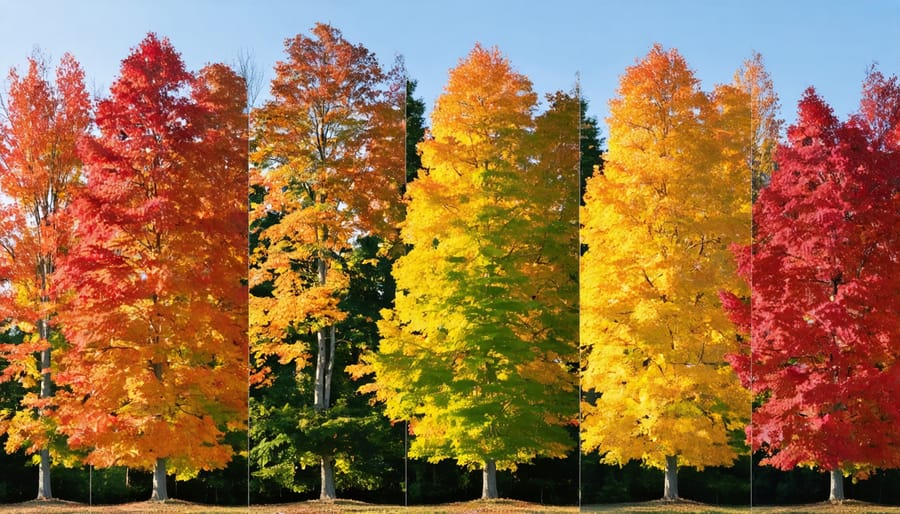
Weather Patterns and Planning
Ontario’s weather patterns can be both a challenge and an opportunity for time-lapse photographers. The key is knowing when and where to capture the most dramatic seasonal transitions. In Southern Ontario, peak color changes typically occur from late September to mid-October, while Northern Ontario sees these changes about two weeks earlier. Plan your shoots accordingly to catch nature’s most vibrant displays.
For the best results, monitor local weather forecasts and plan your setup during stable weather conditions. Avoid days with predicted heavy rainfall or strong winds, as these can not only damage your equipment but also create inconsistent lighting in your final footage. However, don’t shy away from partly cloudy days – cloud movements can add dramatic elements to your time-lapse sequences.
Early spring and late fall offer unique opportunities to capture dramatic weather transitions. Spring’s frost-thaw cycles and fall’s first snow dustings create compelling narratives in your time-lapse projects. The shoulder seasons (April-May and October-November) often provide the most dynamic weather patterns and interesting light conditions.
Pro tip: Create a weather diary for your chosen location. Note the typical patterns, including fog formation times, frost occurrence, and sun positions throughout the seasons. This information becomes invaluable for planning future shoots and understanding local microclimates. Remember to waterproof your equipment and bring backup batteries – Ontario’s humidity and cold temperatures can affect battery life significantly.
Creative Techniques for Seasonal Stories
Composition Strategies
When framing your seasonal time-lapse shots, think like a painter creating a four-panel masterpiece. Start by finding a composition that works across all seasons – this means identifying elements that will remain constant throughout your shoot. Look for sturdy landmarks like mature trees, rock formations, or lakeshores that anchor your frame while allowing plenty of space for seasonal changes to unfold.
Try the rule of thirds, placing your main subject slightly off-center. This creates visual interest and leaves room for dramatic sky changes and seasonal transitions. In Ontario’s parks, a solitary maple tree can become your star performer, showing off vibrant greens, fiery autumn colors, stark winter silhouettes, and fresh spring buds.
Include foreground elements that will enhance each season – wildflower meadows that transform from summer blooms to winter snow, or shorelines that shift from summer waves to winter ice. Position your camera to capture both earth and sky, as cloud patterns and lighting angles will vary dramatically throughout the year.
Consider leading lines that work year-round, like hiking trails, river bends, or fallen logs. These natural pathways guide viewers’ eyes through your composition while showcasing seasonal transformations. Frame your shot with some breathing room around the edges – remember that vegetation might grow taller in summer or become laden with snow in winter.
Pro tip: Take test shots in different weather conditions before committing to your long-term setup. What looks perfect on a sunny summer day might lose impact during overcast winter months.
Editing for Impact
Once you’ve captured your seasonal transitions, it’s time to enhance their impact through thoughtful editing. Start by adjusting the white balance consistently across all frames to ensure smooth color transitions. Ontario’s dramatic seasonal shifts offer plenty of natural contrast, but you can gently boost vibrance to make autumn colors pop or enhance the crisp whites of winter scenes.
When combining your images, aim for a frame rate between 24-30 fps for natural-looking motion. For longer sequences spanning multiple seasons, consider using speed ramping – slowing down at pivotal moments like the first snow or peak fall colors to emphasize these dramatic changes.
Here’s a pro tip: create a subtle vignette effect to draw viewers’ eyes to the center of your frame where the seasonal transformation is most apparent. This works especially well when featuring iconic elements like a maple tree or a lakeside vista.
Color grading plays a crucial role in seasonal storytelling. Consider slightly warming your summer frames while adding cooler tones to winter scenes. For spring and fall, boost the greens and oranges respectively, but keep it natural – Ontario’s landscapes are already incredibly colorful!
Don’t forget about stabilization in post-processing. Even with the best tripod setup, slight camera movement can occur over months of shooting. Most editing software offers stabilization tools that can smooth out any minor shifts, resulting in a more professional final product.
Remember, less is often more when editing time-lapses. Let nature’s transformation be the star of your show.
Capturing the changing of seasons through time-lapse photography is more than just a technical endeavor – it’s a journey that connects you deeply with nature’s rhythms and Ontario’s breathtaking landscapes. As you’ve learned, with the right location, equipment, and timing, you can create stunning visual stories that showcase our province’s dramatic seasonal transitions.
Remember that patience is key in seasonal time-lapse photography. While it may take months to complete your project, the resulting footage will be worth every minute of planning and preparation. Start with accessible locations near your home, perhaps a local park or your own backyard, before venturing to more remote spots in Ontario’s wilderness.
Don’t be afraid to experiment with different angles, compositions, and timeframes. Each season brings its own unique challenges and opportunities, from spring’s dramatic snow melts to summer’s golden sunsets, autumn’s vibrant foliage, and winter’s pristine snowfalls.
Most importantly, practice sustainable photography habits. Stay on marked trails, respect wildlife, and leave no trace. Your time-lapse project can also serve as a valuable record of environmental changes in our region, contributing to a broader understanding of our changing climate.
Whether you’re a beginner or an experienced photographer, now is the perfect time to start your seasonal time-lapse journey. Ontario’s diverse landscapes are waiting to tell their stories through your lens – so grab your camera, pick your spot, and start documenting nature’s magnificent transformation.

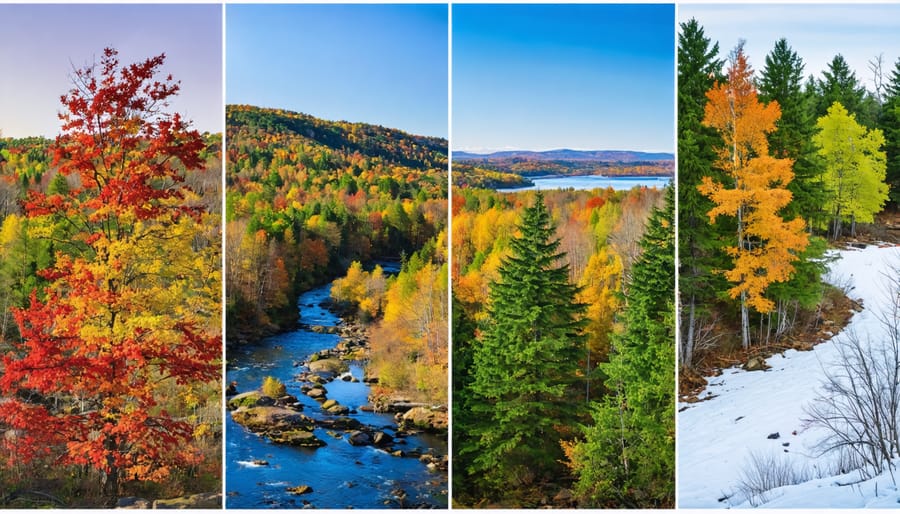
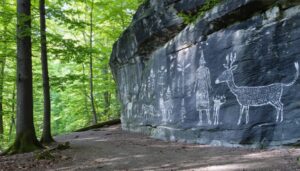
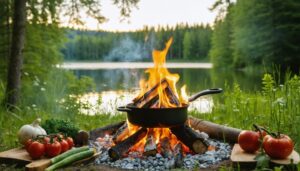
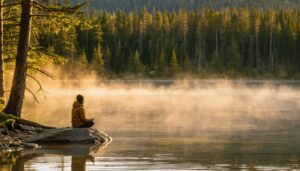

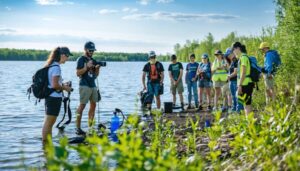

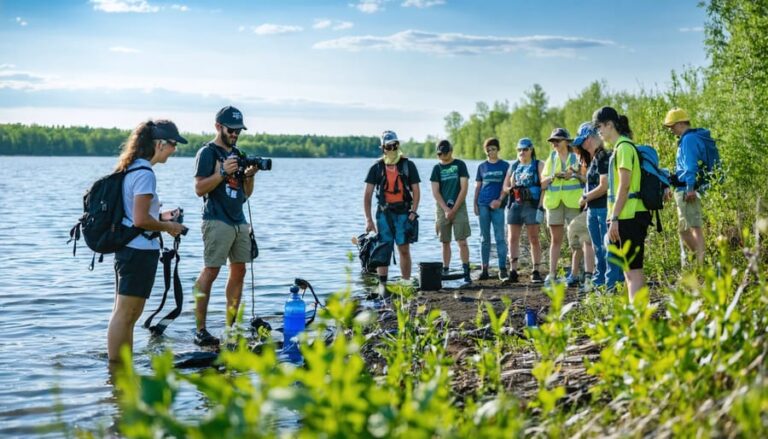
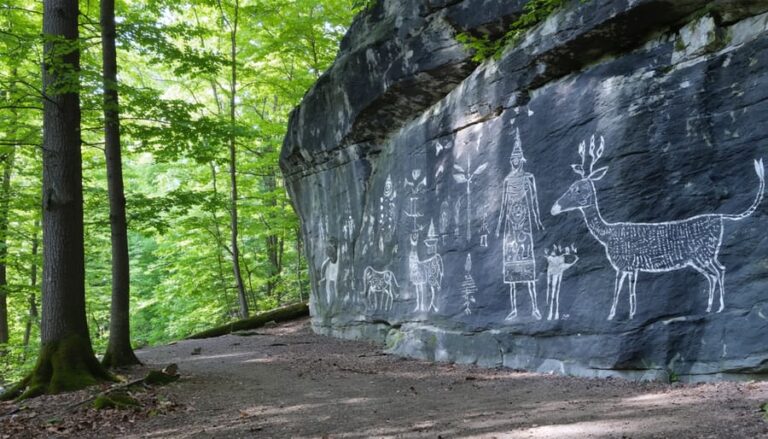

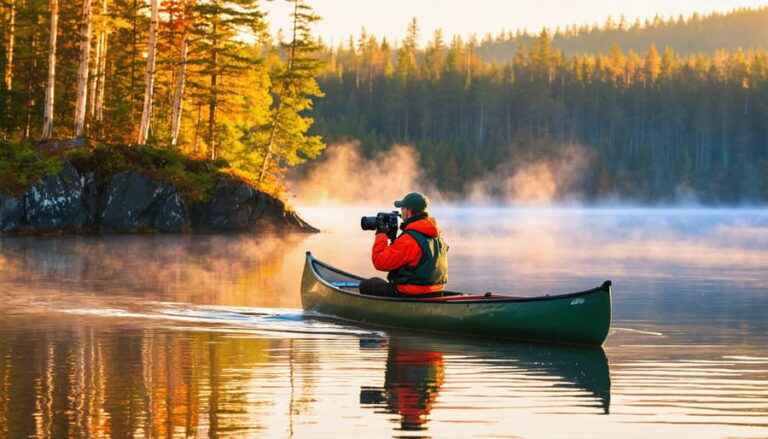

+ There are no comments
Add yours